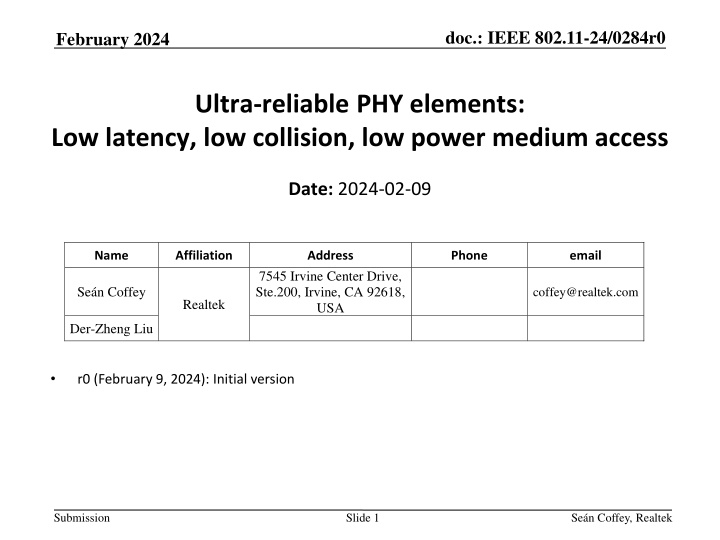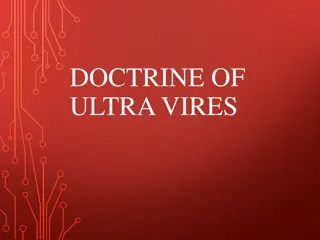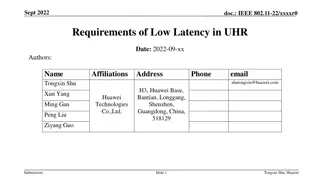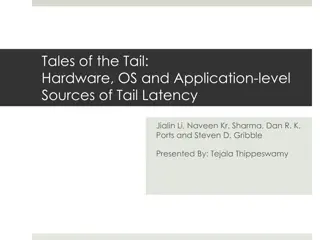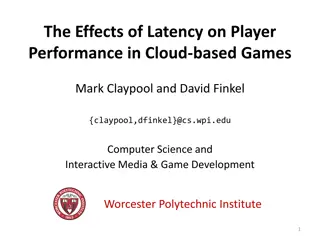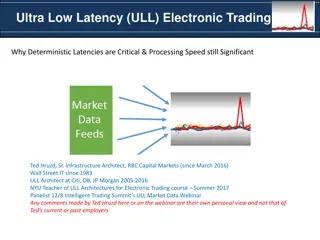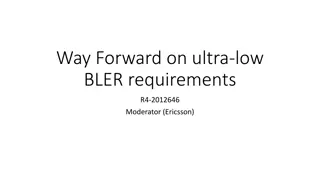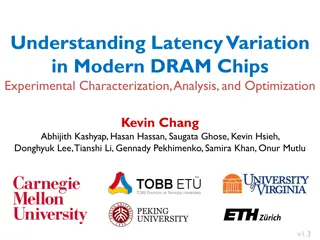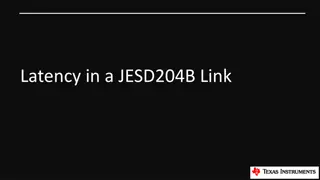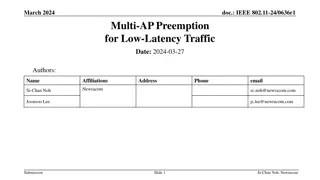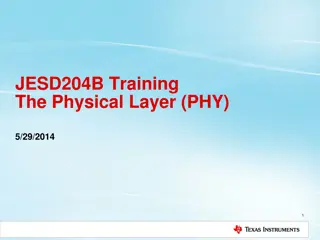Ultra-Reliable PHY Elements: Optimized Building Blocks for Low Latency and Efficiency
The document presents a deep dive into ultra-reliable PHY elements, focusing on achieving low latency, reduced collision, and energy efficiency. It proposes optimized universal building blocks to address these goals effectively, especially in scenarios where many devices may not receive transmissions. Preemption strategies are discussed to minimize tail latency, improve throughput, and manage collisions efficiently in medium access scenarios. The emphasis is on designing common methods for STAs to access the medium swiftly and reliably transmit data, even at lower power levels.
Download Presentation

Please find below an Image/Link to download the presentation.
The content on the website is provided AS IS for your information and personal use only. It may not be sold, licensed, or shared on other websites without obtaining consent from the author.If you encounter any issues during the download, it is possible that the publisher has removed the file from their server.
You are allowed to download the files provided on this website for personal or commercial use, subject to the condition that they are used lawfully. All files are the property of their respective owners.
The content on the website is provided AS IS for your information and personal use only. It may not be sold, licensed, or shared on other websites without obtaining consent from the author.
E N D
Presentation Transcript
doc.: IEEE 802.11-24/0284r0 February 2024 Ultra-reliable PHY elements: Low latency, low collision, low power medium access Date: 2024-02-09 Name Affiliation Address Phone email 7545 Irvine Center Drive, Ste.200, Irvine, CA 92618, USA Se n Coffey coffey@realtek.com Realtek Der-Zheng Liu r0 (February 9, 2024): Initial version Submission Slide 1 Se n Coffey, Realtek
doc.: IEEE 802.11-24/0284r0 February 2024 Abstract UHR has many goals and themes; lower latency; higher throughput for some SINRs; reduced packet loss; improved energy efficiency [1]. Ideally, all these objectives should be addressable by common methods. It is therefore useful to investigate optimized universal building blocks. For all the UHR themes above, it is useful to add methods for STAs: to access the medium efficiently (quickly, and without collisions), outside the scope of pre-scheduled agreements, and to complete transmissions reliably (low or no loss due to interferers), even at greatly reduced transmit power levels. This presentation approaches this design problem from the PHY viewpoint. It is possible to design optimized and universal building blocks that achieve all the above goals, even when many devices cannot hear some or even most transmissions. Submission Slide 2 Se n Coffey, Realtek
doc.: IEEE 802.11-24/0284r0 February 2024 Preemption PHY signaling properties I To derive common methods, we can start with any UHR interest area, and derive detailed requirements, then reuse and apply to other interest areas For example, preemptionis a promising method to reduce tail latency that has been extensively discussed in UHR [2-8]. (For now, consider within-TxOP preemption only.) From 11-23/1229r1, Preemption for Low Latency Application (follow up) , J. Fang et al. (slide 3) Long TxOP currently has lowest overhead, but causes latency for other traffic Preemption solution is to allow interrupts and suspension of the TxOP Submission Slide 3 Se n Coffey, Realtek
doc.: IEEE 802.11-24/0284r0 February 2024 Preemption PHY signaling properties II There will often / usually be no interrupt, so xIFS represents overhead xIFS should be as short as possible There could be multiple STAs that attempt to access an xIFS Must avoid or manage colliding attempts, including when STAs are hidden nodes Natural idea is to have a common signal ( preemption request , PRI ) that is sent by all such STAs, then await response (by TxOP holder) Such a common signal should also be as short as possible Submission Slide 4 Se n Coffey, Realtek
doc.: IEEE 802.11-24/0284r0 February 2024 Preemption PHY signaling properties III What are reasonable limits for xIFS and PR / PRI? Tx/Rx turnaround 4 s Rx/Tx turnaround 4 s AP DL PPDU Short training sequence 8 s STA PR / PRI 9 s is enough for detection plus Rx/Tx turnaround devices do this all the time Detection decision usually made on first 4 s of short training sequence 13 s should be enough for Tx/Rx turnaround, detection, and Rx/Tx turnaround This means that DL transmission needs only to be suspended for one OFDMA symbol DL transmission (if no PR/PRI) could be resumed with no (or little) extra sync signaling Submission Slide 5 Se n Coffey, Realtek
doc.: IEEE 802.11-24/0284r0 February 2024 Preemption PHY signaling properties IV PR/PRI signals indicate interest in transmission, but do not seize the medium: Here AP (as TxOP holder) retains control AP DL PPDU AP might: Poll some known high priority STAs, or Utilize UORA, or Utilize EDCA, or Seek further information, or, Do any of the above after a delay, STA1 PR / PRI STAn PR / PRI Re PHY properties: No pre-negotiation required Might be several simultaneous PR/PRIs Non-common information will be lost STAs cannot seize the medium PR/PRI should be minimum for AP to detect e.g., half short training sequence or some combination of the above, with or without Block Ack handling, Submission Slide 6 Se n Coffey, Realtek
doc.: IEEE 802.11-24/0284r0 February 2024 PHY signaling properties V PR/PRI signals, if very short, can be used far beyond within-TxOP preemption SIFS AP TxOP 9 s Half of Short training sequence 4 s STA1 PR / PRI General-purpose way for (UHR) STAs to notify (UHR) APs they wish to transmit Here STAs use first available slot after TxOP send PR/PRI and then stop In this example, further developments are inherently delayed (Normal medium access rules apply) In principle, any UHR STA might use this opportunity no requirement that this should be restricted to some subset of STAs by permission / negotiation in advance Enables fully responsive / spontaneous protocol (for event-driven traffic) Submission Slide 7 Se n Coffey, Realtek
doc.: IEEE 802.11-24/0284r0 February 2024 UL medium access I A different problem: uplink medium access with no pre-negotiated agreement STA1 wins contention Co-channel STAs process STA1 s preamble independently Unless all such STAs defer, STA1 s transmission suffers interference Co-channel STAs are typically 2 SS devices, listening with 1 SS Co-channel STAs distributed spatially, will receive STA1 at varying Rx powers, some low AP STA1 UL PPDU STAn Interferer Interference is very likely if deployment is dense STA1 s best case scenario then requires reducing rate significantly to overcome interference STA1 is likely to suffer packet loss and delay STA1 may be unable to achieve any meaningful communication, even if otherwise within range Submission Slide 8 Se n Coffey, Realtek
doc.: IEEE 802.11-24/0284r0 February 2024 UL medium access II Situation is better if AP knows STA1 wishes to transmit AP polls STA1 AP reserves medium, polls STA1 AP Tx power >> STA1 s AP is intended receiver, so better placed to protect transmission STA1 transmits In dense deployment, there is still likely to be some STA that transmits, but it may be much farther from the AP AP STA1 UL PPDU STAn Interferer With event-driven traffic, STA1 s main problem is the initial step of informing the AP that it wishes to transmit Part of solution: PR/PRI signal Tells AP that some device wants to transmit AP may then have a variety of ways to proceed Submission Slide 9 Se n Coffey, Realtek
doc.: IEEE 802.11-24/0284r0 February 2024 UL medium access III PR/PRI function can be iterated to enable fast, scalable identification of STAs STA-1 time STA-2 AP-1 PR/PRI Poll for PR/PRI in window PR/PRI response (4 s slots) Poll for slot 6 STA-2 transmits PPDU Submission Slide 10 Se n Coffey, Realtek
doc.: IEEE 802.11-24/0284r0 February 2024 UL medium access IV Same procedure works even if done piece by piece STA-1 STA-2 AP-1 (Delay) (Delay) (Repeatable) This permits scalable, efficient identification of STAs Submission Slide 11 Se n Coffey, Realtek
doc.: IEEE 802.11-24/0284r0 February 2024 UL medium access V Re PR/PRI signals sent outside TxOP, e.g., in first EDCA slot: MAC STA-1 Enables unsolicited high priority medium access by STAs to send initial device present signal STA-2 No need to rely on APs to arrange polls, or to await polls Use only as needed no overhead due to polls with no response AP-1 Any number of STAs can transmit in one slot end of TxOP Received power of STA transmissions can be very low Rx power, AP detects PR/PRI AP decodes data from STA other STAs decode preamble << PHY << Submission Slide 12 Se n Coffey, Realtek
doc.: IEEE 802.11-24/0284r0 February 2024 Coordinated medium access Multiple APs could use PR/PRIs to coordinate low-interference medium access E.g., Multiple APs (same or different ESS) collaborate, e.g., by rotating chair AP role Chair AP coordinates by soliciting PR/PRIs from STAs with traffic Responses do not have to be from STAs associated with that AP For example, BSS can be denoted by slot Chair AP can then allocate time-shared TxOPs Enables low transmit power devices, by facilitating no-interference operation No need for chair AP to decode data from STAs of other APs only needs to detect STS No advance agreement is necessary Coordinated medium access with connectionless, zero state operation Fully anonymized operation STAs send only fully generic transmissions outside ESS Submission Slide 13 Se n Coffey, Realtek
doc.: IEEE 802.11-24/0284r0 February 2024 Notes Reuse and reassembly PR/PRI framework enables fast detection, with many applications Fast detection even with very low / widely different received powers, many STAs Losses due to indirect collisions are minimized Elements of detection, identification, and data transmission are decoupled Timing of elements and relative timing of different elements are easily adjusted PR/PRI framework also enables fast signaling of a small number of bits E.g., AP signals choice of a small number of possibilities by location of PR/PRI signal Testing It s straightforward to check that devices detect lone PR/PRIs standalone PHY test Optimized modular units that can be tested separately ease testing requirements Interoperability testing requirements are now a major bottleneck for industry adoption Submission Slide 14 Se n Coffey, Realtek
doc.: IEEE 802.11-24/0284r0 February 2024 UHR in one sentence Focus and theme: What is UHR , in one sentence? Tying compelling idealized goals to concrete layer 1-2 IEEE 802.11 elements will promote successful deployment and accelerate adoption of the eventual Wi-Fi program. Better still: having goals, methods, and solutions that are capable of being measured and demonstrated. UHR achieves ultra-high reliability by minimizing or eliminating collisions and tightly managing interference, achieving ( among others ) minimum latency and maximum energy efficiency. The framework outlined here fits the theme of ultra-high reliability and links the theme to tangible elements of basic IEEE 802.11 design. Submission Slide 15 Se n Coffey, Realtek
doc.: IEEE 802.11-24/0284r0 February 2024 Conclusion A framework has been outlined that allows STAs: to access the medium efficiently (quickly, and without collisions), outside the scope of pre-scheduled agreements, and to complete transmissions reliably (low or no loss due to interferers), even at greatly reduced transmit power levels. using adaptations of basic IEEE 802.11 channel access and detection methods. The basic PHY elements are scalable and adaptable, and can support many different new functionalities. In addition to the fundamental usefulness of these goals, they fit the theme of ultra-high reliability. Submission Slide 16 Se n Coffey, Realtek
doc.: IEEE 802.11-24/0284r0 February 2024 References 1. Doc. IEEE 802.11-23/0480r3, UHR Proposed PAR . 2. Doc. IEEE 802.11-23/0092r0, Preemption , J. Fang et al. 3. Doc. IEEE 802.11-23/1174r0, TXOP preemption follow up , K. Ryu et al. 4. Doc. IEEE 802.11-23/1192r0, Overlapped indication to support preemption , D. Verenzuela et al. 5. Doc. IEEE 802.11-23/1229r1, Preemption for Low Latency Application (follow up) , J. Fang et al. 6. Doc. IEEE 802.11-23/1242r0, Considerations on Inter-PPDU based Preemption Scheme , J. Moon et al. 7. Doc. IEEE 802.11-23/1886r3, Preemption techniques to meet low-latency (LL) targets , G. Chisci et al. 8. Doc. IEEE 802.11-24/0102r0, TXOP Level Preemption for Low Latency Application , J. Fang et al. Submission Slide 17 Se n Coffey, Realtek
